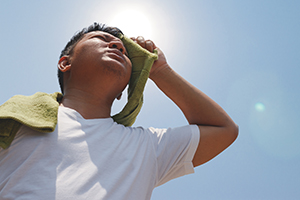 Often heat related illnesses occur when a person’s body is unable to cool itself naturally and the body’s temperature exceeds the normal range of 96-100 degrees Fahrenheit. To help lessen then effects of heat on a worker it is important to implement acclimatization, hydration and rest breaks.
Often heat related illnesses occur when a person’s body is unable to cool itself naturally and the body’s temperature exceeds the normal range of 96-100 degrees Fahrenheit. To help lessen then effects of heat on a worker it is important to implement acclimatization, hydration and rest breaks.
Acclimatization
Acclimatization helps gradually increase a workers time in hot conditions over 7-14 days, so they can adjust to working in a hot environment. Begin acclimating a new worker by scheduling no more than 20% of their usual duration of work in heat on day one and increase their workload no more than 20% each additional day in the heat. You can schedule workers with previous experience working in heat up to 50% of the usual duration of work for day one, increasing to 60% on day two, 80% on day three and 100% by day four. Closely supervise workers until they are fully acclimatized realizing non-physical fit workers may take more time to fully acclimatize. Once acclimatized a worker can maintain their stamina even if not exposed to heat for a few days or while taking a break in the air conditioning.
Hydration
While working in hot conditions it is important to provide a means for hydration. Encourage workers to remain hydrated by providing potable water and cups to allow for individual drinks. Workers should drink one 8-ounce cup of water every 15-20 minutes if performing moderate work in the heat for two or more hours. Replace the water with a sports drink containing electrolytes if you expect work to last several hours with prolonged sweating. However, fluid intake should not exceed six cups per hour.
Rest Breaks
Rest breaks are also important as they encourage workers to take time to cool down and hydrate. Encourage workers to take a rest and water break as they feel discomfort from the heat. Rest breaks allow the body a chance to rid itself of excess heat. As the temperature rises or there is no air movement, it is important to use shorter work periods by increasing rest breaks.
Even following these steps a worker may still experience a heat related illness, so it is important to understand how to recognize them and what to do to lessen the effects. Below are heat related illnesses ranked on severity from the least severe to possible fatal outcomes.
| Heat Related Illness | Signs and Symptoms | What to Do |
|---|---|---|
| Heat Rash/Prickly Heat |
|
|
| Heat Cramps |
|
|
| Heat Syncope (Fainting) |
|
|
| Heat Exhaustion |
|
|
| Heat Stroke |
|
|
Recognizing these heat illnesses and the treatments needed can save your life or a worker’s life. Remember, signs and symptoms can occur in any order, so a person may not have cramps before suffering heat exhaustion.
Need help planning your outside work?
A great resource for planning your outdoor work and understanding the heat index is the OSHA-NIOSH Heat Safety Tool. This app is available for your smartphone, so you have easy access to the current heat index in your area and the risk levels associated with it. By enabling your location in the app, you can calculate numerous conditions to help you plan your work conditions in the field and access hourly forecasts. It also allows you to have first aid information for heat related illnesses readily available. Find out more or download the OSHA-NIOSH Heat Safety Tool app.